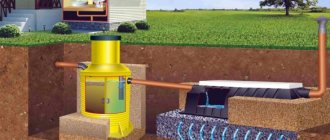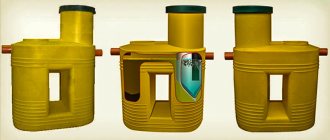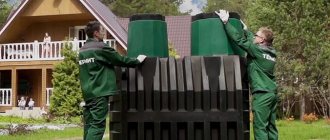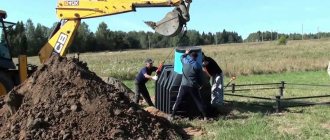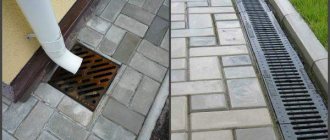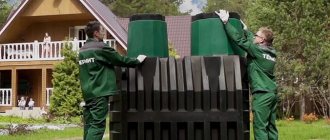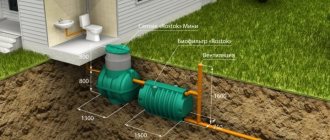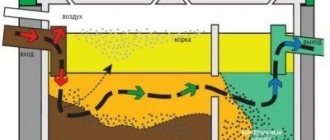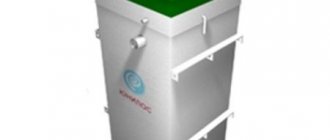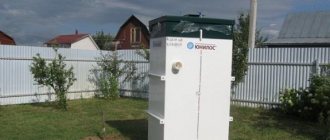Types and designs of the simplest septic tanks for a dacha
In a country house or dacha, an autonomous type of sewage system is installed. This system involves the presence of a septic tank, with the help of which wastewater is collected and stored for disposal. There are different types and designs of simple septic tanks for summer cottages. The devices are based on different principles of wastewater treatment. To choose the appropriate option, you should study the features of each design.
What is a septic tank? The septic tank is designed for treating wastewater in a dacha in an autonomous sewage system. The purpose of a septic tank is to accumulate sewage with further filtration.
Modern models of septic tanks have come to replace the cesspool. If you understand how a septic tank works and how it works, then you can choose the right device model. All septic tanks basically have the same parts in the form of a sealed tank, which consists of one or several chambers.
Organization of septic tanks for cottages with high groundwater levels
The construction of a sewer system can be complicated by the presence of a high groundwater level on the site. These conditions impose restrictions on the treatment of wastewater passing through septic chambers, and the durability of the structure itself is significantly reduced.
The way out of this situation will be the construction of a sealed storage septic tank. Thanks to sealing, excess ground moisture will not be able to interact with wastewater and affect the process of its purification. Such structures have only one drawback. There is a need to regularly use the services of a sewer truck. And this already runs counter to the desire to create a cleaning structure that provides a long period of use without pumping.
Draining water from a septic tank into a ditch or storm drain
To achieve the desired result, you can use a standard scheme with a more complex structure. The design provides for the installation of a sealed container. The material for it can be concrete or plastic. This container must be divided into chambers designed to supply waste water and remove purified liquid.
The process of installing a septic tank with a high groundwater level
Choosing a septic tank for an area with high groundwater
If there is high groundwater in a suburban area, when choosing a treatment plant, you should be guided by some rules. They will help you choose the right type of septic tank and make a quality installation.
Basic Rules:
- The volume of the treatment structure is calculated based on the speed at which wastewater will be processed over a specified period (day).
- Materials of polymer origin or concrete are the safest and most reliable basis for creating a septic tank.
- Horizontally located septic tanks with a small depth can offer the highest efficiency.
- Suitable options for treatment structures: storage or providing the possibility of forced pumping of purified liquid.
- Increasing the number of chambers increases the degree of cleaning.
Scheme for selecting a treatment plant depending on the groundwater level
Groundwater located close to the surface imposes restrictions on the use of certain materials.
In such conditions, you should abandon the construction of septic tanks:
- made of brickwork with gaps;
- from tires;
- from concrete rings.
Perforated pipes for drainage should also be excluded from the list of materials used.
The choice of septic tanks for installation is quite large. Most of them can be installed by hand. You can use improvised means, for example, bricks or tires (only for drains from a country shower) or purchase a ready-made structure from a specialized company.
Bioseptic, what is it?
What distinguishes bioseptic tanks from conventional ones is that they contain colonies of microorganisms that feed on human waste and process it, although there are also some design differences. On sale today you can find many different models that will differ in performance characteristics (volume, type of material, wall thickness, etc.) and their efficiency, but their operating principle is identical.
Septic tank with live filling
They are a container divided into compartments, or a sequence of containers, as in the case of a septic tank with an overflow, connected by pipes and a system of air filters. In the first compartment, the wastewater settles, all solid waste remains at the bottom, and water with small fractions flows into the next tank, which can play the role of a secondary settling tank, or can be designed to drain water.
Biological water purification system
Special microorganisms are placed in containers with accumulated wastewater, which perform cleaning - the outlet water can be purified by 95-98%, it would be quite possible to bathe in it. There are two types of bacteria - anaerobic, which do not need access to air, and aerobic, for which oxygen is supplied to the system using a compressor. The latter type of septic tanks are called active, since they require electricity to function properly. In both cases, wastewater treatment is extremely effective; such septic tanks cannot be filled for a long time, but they also require maintenance.
To understand how live bacteria for septic tanks work and how they should be used, you should first understand what they are and in what types they are produced. We will consider this topic in more detail in a special article.
Types of biological septic tanks
There are a large number of models of bioseptic tanks on the market today, which, as we have already said, differ in various parameters, for example, in the material of manufacture - concrete, metal, plastic. This affects more the complexity of the installation and the durability of the structure, but now we are interested in something slightly different, namely the cleaning system used. There are two types:
- A system with biofilters - a septic tank is equipped with a treatment device with an internal area sufficient for the passage of wastewater. When passing through such a filter, the wastewater is saturated with microorganisms and undergoes mechanical filtration. All work takes place in a sealed tank.
- The second system is called bacterial. It does not provide for the presence of special places where microorganisms live - they multiply and “work” directly in the sump tank. The system can also use aerobic bacteria.
Uniform bioseptic design
Construction of a septic tank from Eurocubes with your own hands without pumping
Eurocubes are containers made of plastic. For the installation of cameras made of this material, a base of thick concrete is made. The septic tank is fixed to this base. This procedure is designed to ensure that the structure does not move under the influence of groundwater that moves under the surface of the soil. Rising ground moisture can also move a poorly secured structure.
Construction of a septic tank from Eurocubes: 1 - flasks of Eurocubes; 2 — connecting overflow pipe; 3 — extension pipe; 4 — inlet tee; 5 — outlet tee; 6 — insulated wooden cover; 7 — hatch cover; 8 - ventilation pipe; 9 — weather vane; 10 — supply pipeline (100 mm); 11 — outlet pipeline (100 mm); 12 - concrete base; 13 - concrete filling; 14 — thermal insulation layer; 15 - concrete well ring; 16 — reinforcing mesh
Before installation, the plastic container is insulated with foam plastic. After which it is mounted in the pit. Then the tank is filled with water and concreted on the sides. The country septic tank is even insulated from above. A pipe system must be brought to the surface to provide ventilation.
This type of purification design requires the use of additional elements that will allow achieving a full level of wastewater treatment. For these purposes, it is recommended to use filter cassettes or filtration fields.
The process of installing a septic tank from Eurocubes
Comparison of septic tanks by basic parameters
To better understand which septic tank is better for a dacha, in each specific case, let’s compare them with each other according to their main characteristics.
| Septic tank with filtration well | Septic tank with filtration field | Septic tank with infiltrator | Septic tank with biofilter | Deep biological treatment station | |||||||
| Septic tank cost | Low | Average | Average | Average | High | ||||||
| Cost of arrangement | Low | High | High | Average | Average | ||||||
| Difficulty of installation | Average labor intensity | High labor intensity | High labor intensity | Average labor intensity | Average labor intensity | ||||||
| Service frequency | Cleaning drains every 6 months, replacing backfill every 5 - 7 years | Replace the pillow every 10 years | Replace the pillow every 10 years | Sludge is extracted every six months, it is necessary to add biological products | Sludge is extracted every six months, all operations can be carried out manually | ||||||
| Degree of wastewater treatment | Low | Low | Low | Average | High | ||||||
| Energy dependence of the system | Non-volatile | Non-volatile | May be volatile | Non-volatile | Volatile | ||||||
The cost of a septic tank and its arrangement
There is a simple rule - the simpler, the cheaper. The least amount of money will have to be spent on a regular septic tank with a filtration well, and installing a system with a filtration field or infiltrator will cost more. Biological treatment systems have the highest price, especially if you purchase a device made in an industrial environment, but if used correctly, the costs will quickly pay off.
Difficulty of installation
Here, purchased biological treatment systems are clearly in the lead, which are often produced by manufacturers in one housing or several of equal size and connected in series. For them, you just need to dig one hole and install the entire system in it.
It is a little more difficult to install a septic tank with a filtration well, for which you need to dig several holes, and at the bottom of the latter you also need to lay a cushion of sand and crushed stone.
Septic tanks with a filtration field or infiltrator can be considered the most labor-intensive to install. For each of them, you will have to remove soil from a fairly large area, put sand and gravel (crushed stone) into the resulting hole, install filter elements and fill everything back with soil.
Installation of the infiltrator.
Installation of the filtration field.
Service frequency
Any septic tank needs to be cleaned much less frequently than a cesspool - the more perfect the design, the fewer reasons to call the sewer trucks:
Septic tank with filtration well . The overflow tanks of the septic tanks themselves are cleaned approximately every six months, and the crushed stone and sand at the bottom of the well must be changed every 5-7 years.
Septic tank with filtration field or infiltrator . Since purified water is discharged over a large area, it is enough to replace the pillow once every 10 years. The silting time of sedimentation tanks depends entirely on their size and the intensity of sewage use.
Biological or deep treatment stations . It is enough to remove the accumulated sludge once every six months, and all operations can be carried out manually.
Degree of wastewater treatment
According to the level of purification, all septic tanks are divided into devices for mechanical action on wastewater and combined - mechanical-biological. In the first case, the purification level will be about 70% - such water cannot even be used for irrigation, and only lawn grass can be planted above the filtration field or infiltrator. In the second case, the degree of wastewater purification reaches 95-98% - these are normal parameters for industrial water, which can be used for irrigation or other technical needs.
System non-volatility
Of the presented systems, only two are energy-dependent: a septic tank with an infiltrator with an intermediate well and a deep biological treatment station. In the first case, an electric drainage pump is used, and in the second, compressors plus airlift pumps are used. Depending on the power of the entire device, energy consumption can range from 1.5 to 30 kW per day.
If you notice an error, a non-working video or link, please select a piece of text and press Ctrl+Enter .
0
Price of septic tanks for a private house and design requirements
The domestic market offers a wide range of treatment structures, among which there are many budget septic tanks for summer cottages without pumping.
The calculation of the cleaning structure is carried out taking into account the principles of multi-stage cleaning. The purification process can be carried out using 3 or 2 chambers.
Table of ratings and prices of popular designs:
| Name | Cleaning efficiency, % | Salvo discharge, l | Cost, rub. |
| Topas 8 | 98 | 440 | 106900 |
| Eco-Grand 5 | 98 | 250 | 73600 |
| Unilos Astra 3 | 98 | 150 | 66300 |
| Triton | 98 | 500 | 48000 |
| Rostock | 90 | 250 | 26800 |
| Tank 1 | 70 | 600 | 34900 |
| Termite | 70 | 400 | 73720 |
In some cases, conditions make it possible to create a single-chamber treatment facility with a capacity of 20-30 m³, which will be more effective than a three-chamber septic tank.
Diagram of a three-chamber septic tank with aeration
Purpose of cameras:
- the first is intended for the accumulation and subsequent separation of wastewater into fractions;
- the second – performs the function of purification (here the process of decay and removal of organic matter occurs);
- the third is used for final filtration and removal of liquid into the ground.
With the exception of the drainage tank, all chambers must be sealed.
Rating of the best septic tanks for a country house
We offer a mini-rating of treatment systems, compiled based on reviews from those who actively use them on their sites. The top best include:
- "Topol", . Purifies waste liquid by 99%. Maintenance is simplified due to the non-standard design of the first compartment. It is possible to clean the device yourself.
- "Eurobion" from "Yubas". The rhythm aeration tank allows the system to operate even if the sewer is not in constant use.
- "Triton" and "Tank" from "Triton-plastic". A wide range of septic tanks and storage tanks of different capacities. From mini and micro models to 10,000 liter tanks.
- "Astra" from Unilos." Performs effective multi-stage cleaning.
So, how to choose a septic tank for a private home? It is necessary to accurately determine the volume of sewage, find out the type of soil, and the level of groundwater rise. All this will help you choose the type of device. All that remains is to select the material and volumes. The range of recycling systems is very wide, making a rational choice will not be difficult.
Material for septic tank
When planning to build a septic tank at your dacha with your own hands, different materials are used:
- Reinforced concrete well rings;
- Concrete;
- Eurocubes;
- Brick;
- Car tires and other auxiliary materials.
Septic tank made of concrete rings
This option is one of the most common. Installation is carried out quite quickly, and the volume of the chambers is determined taking into account the diameter of the well rings used:
- Before installing the rings for the storage chambers, the bottom of the pits is concreted, and where a filter well is supposed to be installed, a cushion of crushed stone is made.
- Concrete structures are installed one on top of the other. When building a septic tank with your own hands from rings, the diagram must take into account the supply of all necessary pipes to the wells, taking into account their slope and diameter.
- Future chambers are carefully sealed inside and out using cement mortar, modern coatings and weld-on waterproofing materials.
- When the cameras are installed, the pipeline is connected and thermal and waterproofing is done, the pits are backfilled.
Concrete septic tank
When planning the construction of a septic tank for a summer residence, quite a lot of people choose the most durable and durable option, in their opinion, which is a monolithic concrete structure:
- When building such a septic tank, at the first stage, the bottom of the future chambers is concreted, after laying the reinforcing mesh. To prevent the metal from undergoing corrosion, which is inevitable in conditions of constant moisture, the layer of concrete on top of the mesh should not be thinner than three centimeters.
- Then, having erected the formwork and strengthened it with reinforcement, the walls of the chambers are concreted and partitions are made between them.
- Construction ends with pouring the ceiling.
Concrete construction requires careful and sufficiently long drying. This stage may take up to two weeks, and to ensure even drying, the solution is covered with film.
Country septic tanks from improvised means
If the dacha is used periodically and only in the summer, then when considering the question of how to make a septic tank for a dacha with your own hands, you can make a fairly simple septic tank from scrap materials. These could be tires or plastic barrels. It will not be possible to achieve tightness and long-term durability here, so you should not use the structure for cleaning and storing toilet drains. But for a country shower, such a septic tank is perfect.
Rating of biological products and cleaners for septic tanks and country toilets
Useful information for our readers-dacha residents: a list of liquid and powder products for cleaning autonomous sewer systems (septic tanks).
Highlight:
- Biological products for septic tanks and cesspools - a powdered product that accelerates the decomposition of waste in the country toilet;
- Cleaners for septic tanks and country toilets - a liquid drain cleaner containing special bacteria;
- Biogranules for rapid waste decomposition;
- Concentrated biological preparation for wastewater treatment - neutralizes aggressive chemicals that enter waste from the use of washing powders, detergents, etc.;
- Bioactivator for septic tanks - ensures rapid decomposition of waste.
Such products contain natural microorganisms (bacteria) that decompose fossils, fats, paper, and eliminate unpleasant odors in country toilets.
To select a suitable product, follow the link>>>
There are DISCOUNTS for our readers in the LEROY MERLIN store.
Buying online is cheaper than buying in a store (online prices are lower)! It is very profitable, convenient and safe: you can buy goods without leaving your home or visiting a store. All purchases will be delivered to your home.
In addition, in the online store, on each product page you can see the exact characteristics and real customer reviews.
Complex septic tanks, two-chamber, three-chamber
Complex septic tanks are divided into two or three sections (A, B, C), a pipe for supplying the initial sewage waste water (E), a discharge pipe for purified water (F), and blockers between the sections.
Depending on the wastewater flow, the following should be taken:
- single-chamber septic tanks - with wastewater consumption up to 1 m3 per day;
- two-chamber - up to 10 m3 per day;
- three-chamber - over 10 m3 per day.
The first section (zone A) of the septic tank is directly connected to the supply sewer line on one side, and on the other - through a blocker system with the second section (zone B). Then through the blocker (hydraulic seal) with the third section (zone C). Zone A serves as the primary septic tank for coarse sludge. In this chamber, the primary, rough cleaning of household wastewater entering the septic tank from suspended small and large particles is naturally carried out. Sand, small potato peelings, etc. settle at the bottom of the chamber (anything that can pass through the sink in the kitchen or bathroom).
The second section (zone B), the digester, serves as an anaerobic reactor. Here, the decomposition of chemical compounds formed as a result of the use of various detergents, personal care products and the decomposition of organic compounds of natural origin occurs.
The third part (zone C) plays the role of the final clarifier of domestic sewage. Through final gravitational settling of suspended particles, clarified wastewater reaches a purification level of up to 65% of the initial pollution level.
After passing through the septic part of the treatment plant, wastewater is sent for soil treatment. In cases where soil post-treatment cannot be performed: the groundwater level is too high (≤ 0.4 m from the ground surface level) or increased quality of wastewater treatment is required, a trickling biofilter (bioseptic) is used.
Autonomous septic tank with power supply
These models are a special type. Their contents decompose due to bacteria that require oxygen, and they can be purchased at specialized outlets. The difficulty is that the activity of these bacteria must be maintained, and therefore the constant presence of air must be ensured. To do this, special compressors with an aerator are installed at the bottom of the septic tank. As a result of such processing, contaminated wastewater can be subjected to high-quality biological treatment.
At the exit, all sewage is divided into three types:
- Residue that cannot be processed and settles to the bottom ends up being removed independently;
- Water;
- Biological gases that escape through ventilation.
This process is simple and convenient, because a small percentage of sediment remains, and the purified water goes into the ground and nourishes it. All that is required of the owner is to clean the tank of solid accumulations.
What are the benefits of a powered septic tank:
- All contents can be quickly recycled;
- Cleaning efficiency reaches 98%;
- Easy tank cleaning;
- An ideal option for those who permanently live in the house.
Despite the fact that the system is almost ideal, it also has its certain disadvantages.
Namely:
- Large price category;
- Structural complexity;
- Due to the operation of the compressor, there is a high cost of electricity.
If you need a regular toilet tank, then it is better to use a simpler option. After all, if you are not at the dacha very often, there is no point in spending money on such equipment; it’s another matter if this is your permanent place of residence and the tank is an irreplaceable part.
Construction of a simple septic tank
A septic tank is a container, a rectangular or round well, through which wastewater flows very slowly, which makes sediment possible. Such sediment is not removed until it rots (six months, a year). The rotting process is accompanied by fermentation and the release of gases. They lift sediment particles upward, forming a crust (sometimes 0.5 m thick).
The body of the septic tank can be made of concrete or plastic, but must be sealed.
The septic tank is easy to use. The settling well can be cleaned 1-2 times a year. After this, a small amount of sediment should remain in it to survive the new arrival.
Full septic tank - evaluate the quality of the septic tank by smell
You can find recommendations for building a septic tank without pumping (cleaning), but this is complete nonsense - the septic tank must be regularly cleaned at least once a year. This is a requirement of sanitary standards. You are building a domestic sewage system, not a plant for microbiological weapons of mass destruction.
The simplest septic tank on an estate is a single-chamber septic tank. It can be easily built with your own hands. It may be round in plan. It is assembled from reinforced concrete rings with a diameter of 1.0 m. The well cover is collapsible. It must be provided with natural ventilation in the form of a steel pipe, which must be covered with kuzbaslak.
The capacity of the septic tank must be at least three times the wastewater flow rate.
With a wastewater flow rate of up to 0.5 m3 per day, a single-chamber septic tank has the following dimensions:
- required capacity - 1.5 m3;
- diameter of reinforced concrete rings - 1.0 m;
- the total depth of the well is 2.95 m.
Fig.1.
Construction of a simple septic tank (diagram) It is recommended to plaster the inside of the septic tank with cement mortar (1:2) 1.5 cm thick with grout.
The tray of the pipe entering the septic tank should be located 0.05 m above the liquid level in it, and the exit pipe should be 0.02 m below this level (Fig. 1).
Requirements for septic tanks for summer cottages
All country septic tanks must meet certain requirements:
- The design of the septic tank is calculated taking into account the principle of multi-stage cleaning in two or three chambers in series. The first container of a septic tank for a summer residence serves to accumulate the separation of wastewater into fractions. Solid waste sinks to the bottom, and liquid and light fractions go to the top. This water enters the second chamber, where it is further purified from organic matter. In the filter well, water is purified and subsequently discharged into the soil.
- All chambers, except the one where wastewater is discharged to the outside, are as sealed as possible.
The principle of operation of a septic tank
The operating principle of a septic tank is based on the decomposition of various microbial cultures and the removal of colloidal and dissolved organic substances from domestic wastewater.
The activity of the microflora of the septic tank affects the degree of treatment of household wastewater, the operation of the installation, as well as the absence or presence of odors during the processes. The most important factors influencing the activity of microorganisms are:
- presence of organic matter in household waste;
- temperature of domestic waste (optimally 10-35°C);
- access to oxygen installation;
- effluent acidity value;
- absence of toxic substances.
The septic tank cleans household wastewater both with the use of bioenzymes and without the use of these drugs. The use of bioenzymes allows one to sufficiently accelerate the processes of decomposition of organic substances and increase the quality of wastewater treatment.
Factors influencing the choice of septic tank
In theory, you can choose your own type of construction for each private house or cottage, so there are no bad or good treatment facilities. It’s just that some owners do not take into account the specific conditions on their site.
Consistently installed plastic structures.
What do SNiPs say?
Installing a septic tank in a private home is far from a personal matter, as many people believe. Improper disposal of household waste can be dangerous not only for you or your area, you can cause irreparable harm to the entire area, and to prevent this from happening, there are restrictions prescribed in SNiP.
One example of site planning.
- As far as I have come across, the most important factor influencing the choice of a particular design is the presence of a drinking well or well nearby. In this case, it is necessary to take into account the direction of movement of groundwater:
- If water moves from the well, passes under the septic tank and flows further, then a treatment structure with the possibility of partial diffusion can be installed 15 meters from the water intake;
- When the drinking water intake is arranged parallel to the future septic tank (again, we are guided by the direction of movement of groundwater), then the distance between them should be at least 30 meters;
- But the most inconvenient option is when groundwater, having passed the point where the septic tank is installed, rushes towards the water intake. Here the distance only starts from 50 meters. In general, in such a situation, it is advisable to consult the local SES. There have been cases when owners were fined for having their open septic tank located 70m from the well.
Operation of a sewer truck.
As you know, water always flows from top to bottom, so in order to determine the direction of movement of groundwater, you should be guided by the slope of the area on which your site is located. If the landscape is absolutely flat, then focus on the nearest body of water; underground rivers always flow in this direction.
Scheme of a two-chamber design with filtration.
- The second important limitation is the distance from the septic tank to the foundation of the house. It is believed that it should be at least 5m. Otherwise, the heavy foundation may sag and cracks will appear along the walls of the house;
- A sump tank intended for periodic pumping with a sewer truck must be mounted no further than 3 m from the fence bordering the roadway, but no closer than 1 m from the same fence. If you install the structure further, the machine may not have enough hose length; there is a maximum of only 4 m. And if closer, then when a car approaches an underground reservoir, it can damage the edge of the structure;
- Neighbors are different and in order not to aggravate relations, it is better to dig a septic tank no closer than 4m from the neighbor’s fence, according to SNiP this is the minimum.
- There is also a requirement not to locate the septic tank closer than 3m from fruit-bearing edible vegetation, but it is your personal choice whether to comply with it or not.
Wastewater treatment plant "Ekopan".
What kind of soil is on your site?
Let’s assume that you “fit” into all of the above rules. Now you need to choose a design that is optimally suited to the type of soil on your site.
Unit "Triton" mini.
On easily absorbent soils, such as chernozems, sandstones or, at worst, relatively loose loams, you can freely install almost any structure.
The absorption capacity of such soils is quite large, therefore, with proper installation, the potential of a medium-sized drainage septic tank is usually enough for at least 5 - 7 years of operation without calling sewer trucks.
Purification unit consisting of four chambers.
If there is clay under the fertile layer, then it is better to install a structure with three or more chambers. Or install a two-chamber septic tank and install a separate drainage field with an area of about 30 m².
For areas based on a rocky base, as well as in places where groundwater rises too close to the surface, choosing a septic tank is the most difficult. Let's leave sealed tanks that require complete pumping alone; they can be installed anywhere, but they are too expensive.
Three-chamber facility for wastewater treatment.
The price of a personal filtration station with a full cleaning cycle is also not affordable for everyone. All that remains is a three or four level septic tank with the most complete cleaning possible.
Moreover, it is desirable that the first two chambers be sealed and are not just settling tanks, but reservoirs with active cleaning. Plus, in order to dispose of treated wastewater, you will still have to make a drainage field of substantial size.
Calculation of the volume of the structure
The installation of a septic tank in a private house, or rather its normal operation, directly depends on the performance of the structure. If previously the level of comfort was determined by the ability to take a shower, wash oneself and wash the dishes, now water consumption for a washing machine, and in some cases for a dishwasher, has been added to this list.
When starting such calculations, you should not flatter yourself and put the data to the minimum; believe me, you will regret it more than once. Personally, when I calculate a septic tank, I always add one extra calculation unit.
A reservoir with sequentially arranged cells.
In general, according to the standards, about 200 liters of water are provided per person per day. If four people live in a house, then the planned consumption will be 800 liters. Here it is better to immediately calculate the cost not for 4, but for 5 people. After all, life goes on, which means new additions to the family, unexpected guests and other factors can nullify all your beautiful calculations.
But that's not all. When choosing a septic tank model, you need to keep in mind that the volume of the first, by the way, largest receiving chamber should be at least three times the daily water consumption rate in your home.
In other words, if according to your project 5 people can use 1000 liters (1m³) per day, then the receiving chamber should accommodate at least 3 cubic meters.
Homemade concrete sump.
Features of a septic tank made from barrels with your own hands
The barrel cleaning system follows the same principle as other septic tank options. It may consist of two or three chambers. The process of moving wastewater into containers is carried out by gravity. To achieve this effect, installation should be performed below the level of the sewer pipes.
This type of structure can be used for several years. To increase the period of effective use, it is recommended to check the first container for clogging or silting. The volume of the septic tank is increased by installing an additional barrel.
Septic tank made of concrete rings and a metal barrel
The cleaning system is made on the basis of plastic or metal barrels. The main condition for quality is tightness. Metal tanks require special anti-corrosion treatment with protective agents. Therefore, many owners of suburban areas prefer structures made from plastic barrels.
Advantages of plastic elements:
- extensive range;
- simple installation system (no additional preparation of material is required before installation);
- high degree of resistance to aggressive wastewater;
- long service life;
- high level of tightness (good protection of the system from leakage of waste or penetration of groundwater);
- light weight (simplifies the installation process, eliminates the need to use heavy special equipment).
A septic tank made of plastic barrels is easy to install and durable
Advantages and disadvantages of bioseptics
Like any other thing, a bioseptic can have a number of positive and negative properties. Here's what you can specifically note:
- Bioseptic tanks are very environmentally friendly - you do not pollute the environment and your yard, the output is clean water, which quietly goes into the ground. Even the high density of such septic tanks over a certain area will not pollute groundwater. The water can even be discharged directly into the reservoir - you will not cause any damage to nature.
- Simple installation and operation - a septic tank purchased from the factory is already a complete, ready-to-use device, for which you only need to dig a pit, pour a drainage pad, install, connect and fill it back up. Even options with compressors will not cause you any difficulties, except for repairs if the unit fails.
Aerobic septic tank with biofilter - The bioseptic will serve you faithfully for at least 50 years, which is a lot. Much depends on the material from which the structure is made.
- Bioseptic is a compact device. Its operating principle does not imply the need for large volumes of storage tanks. This again tells us about the ease of installation - no need to dig a huge pit.
- This type of septic tank is suitable for installation in any type of soil. Its body is completely sealed and does not imply any leakage, which will lead to soil contamination.
- After purification, the water does not need to be poured into the ground - it is perfect for watering plants, it will not have any odor.
Aerator for septic tank
If we talk about the disadvantages of such systems, then it is worth noting, first of all, the following:
- High cost, which is an obstacle for many people when choosing, especially if we are talking about a summer cottage where they will not use it often.
- Any bacteria will gradually die out or be washed out of the system by water. Therefore, in order for it to constantly function normally, biological drugs must be regularly added to it.
- The system must work constantly, since in the absence of nutrients the bacteria will die quite quickly - to restore them completely, a single injection of a large number of drugs will be required.
- Bacteria can die due to certain substances discharged into the sewer, for example, chlorine will have this effect, that is, if you have a central water supply on your site, through which chlorinated water is supplied to the house, it becomes unreasonable to use a bioseptic tank, the bacteria will die very quickly. But if you have a well on your property, this solution will be very successful.
Connecting aerobic septic tanks to electricity can also be considered a disadvantage - this is both its consumption and the death of organisms when disconnected.
Biological septic tank for water purification in your dacha
In general, if you are willing to spend money on the periodic purchase of biomaterial for a septic tank and find a decent amount for its purchase, you will receive a wonderful assistant in your everyday life. Such a septic tank will cope perfectly with a large amount of wastewater and can be safely connected even to a large house. The positive aspects and long service life will pay off your costs over time, and there is no need to call a vacuum cleaner once a month.
